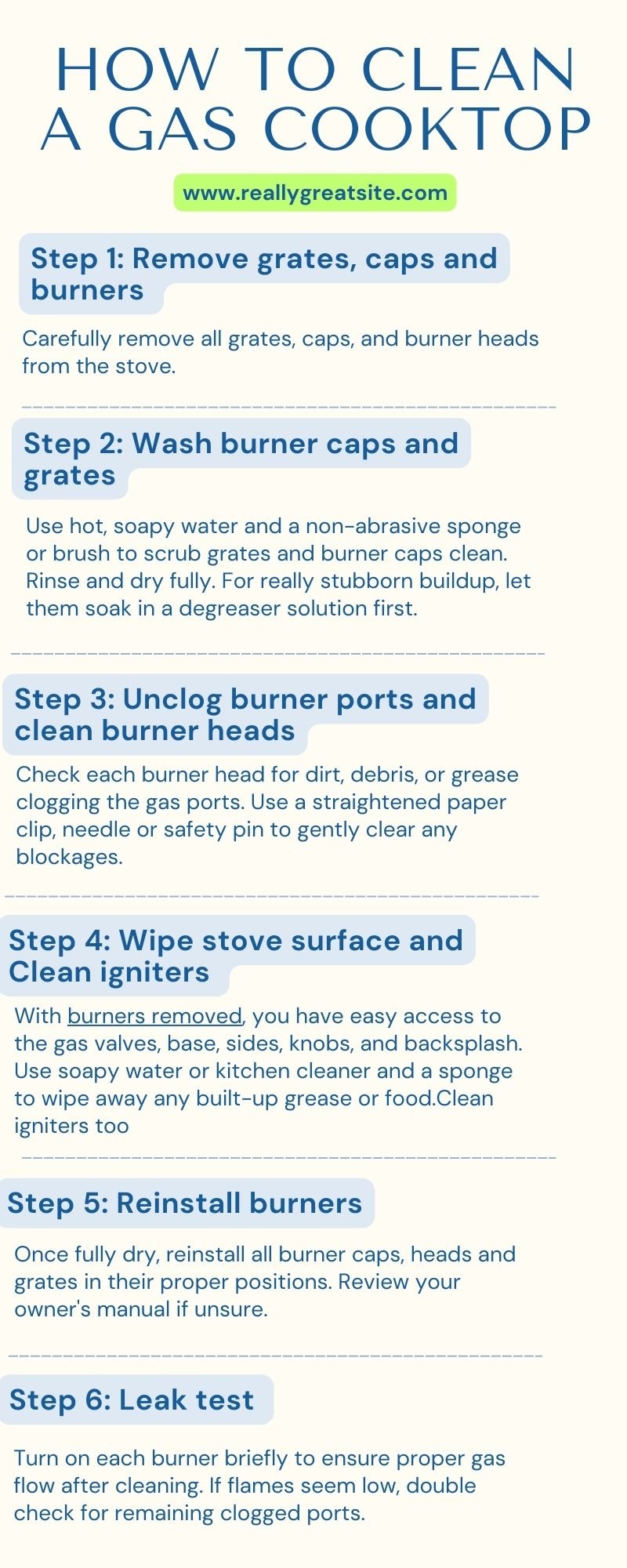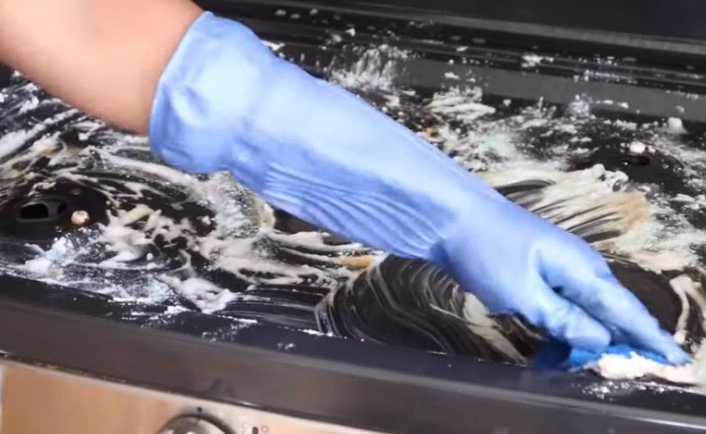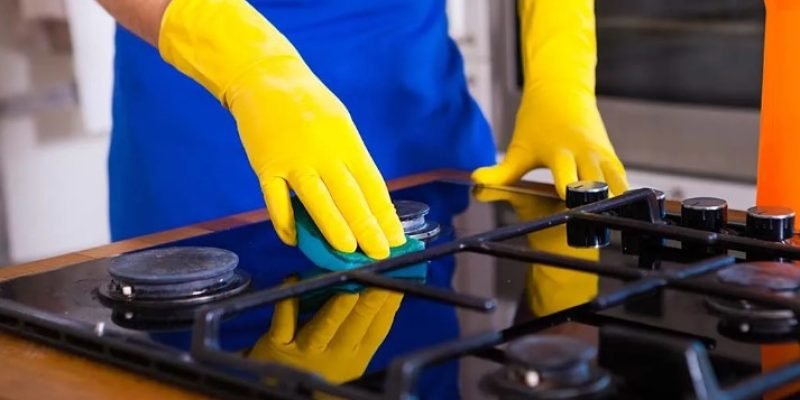Is your gas cooktop looking a little dull these days? I am talking about grease splatters, baked-on spills and dusty burners. If this is you, don’t worry, bringing that puppy back to shiny and spotless is easier than you think.
As a gas stove owner, I’m all about keeping mine in tip-top shape. Not only is it more hygienic for cooking up meals, but keeping your gas range clean improves safety and performance too.
Let me show you how to do it just right!
How to Clean a Gas Stove – Simple Step-By-Step Process
Cleaning your stovetop is very important. According to the New York HomeClean co-founder, Andrii Gurskyi:
“Keeping a gas stovetop clean is an essential aspect of maintaining your kitchen hygiene……. A dirty stovetop not only looks unappealing but can also impact your cooking.”
Over time, all that cooking, frying, and boiling takes a toll on your gas stovetop. Burner ports get clogged, grates get grimy, knobs get gunky – you name it. But having a filthy cooktop isn’t just an eyesore – it can actually lead to some dangerous issues over time:
- Clogged ports cause uneven flames that increase fire risk
- Sometimes igniter fails to work
- Grease buildup is a fire hazard if ignited
- Dirty burners can emit higher levels of CO and NO2 gases
- Grime obstructs gas flow, reducing cooking power
Luckily, with some basic cleaning, you can get your gas stove back into tip-top shape. We’ll walk through the process step-by-step, from burners to grates and everything in between.
Follow these steps, and you’ll be done in 30–60 minutes:
How to Clean a Gas Cooktop Infographic
Step 1: Remove Grates, Caps and Burners
Carefully remove all grates, caps, and burner heads from the stove. This allows full access for cleaning. Place the removed parts in the sink or on towels.
Step 2: Wash Burner Caps and Grates
Use hot, soapy water and a non-abrasive sponge or brush to scrub grates and burner caps clean. Rinse and dry fully. For really stubborn buildup, let them soak in a degreaser solution first.
Step 3: Unclog Burner Ports
Check each burner head for dirt, debris, or grease clogging the gas ports. Use a straightened paper clip, needle, or safety pin to gently clear any blockages.
Step 4: Clean Burner Heads
Scrub away surface grime on burner heads with a mild abrasive cleaning pad. Avoid damaging the metal. Rinse and dry thoroughly after cleaning.
Step 5: Wipe the Stove Surface
With burners removed, you have easy access to the gas valves, base, sides, knobs, and backsplash. Use soapy water or kitchen cleaner and a sponge to wipe away any built-up grease or food.
Step 6: Clean Igniters
Check each ignition electrode for dirt buildup preventing spark ignition. Carefully wipe clean with a damp cloth or cotton swab.
Step 7: Reinstall Burners
Once fully dry, reinstall all burner caps, heads and grates in their proper positions. Review your owner’s manual if unsure.
Step 8: Leak Test
Turn on each burner briefly to ensure proper gas flow after cleaning. If flames seem low, double-check for remaining clogged ports.
And just like that, you have a sparkling clean gas cooktop once again!
How to Clean Gas Stove Burners
The burner heads bear the brunt of the cooking mess and need frequent attention to keep your gas range running safely. Here are tips for deep cleaning those burners:
- Remove buildup: Use a scrub brush, soap, and water to remove any gunky debris on the burner head surface. Avoid abrasive scouring pads to prevent metal damage.
- Unclog ports: Straightened paper clips are perfect for gently clearing any food or grease from the burner ports. Work carefully around the entire port area.
- Remove discoloration: For stubborn stains, try cleaning burner heads with baking soda and vinegar paste. Light scouring with wet steel wool also works. Rinse well after.
- Dry thoroughly: It’s crucial burners are completely dry before returning to service. Trapped moisture can affect gas flow. Give them time to air dry fully.
- Double-check: Check the burners closely for any remaining particles that could clog ports partially. Even small blockages reduce flame efficiency.
How to Clean Gas Stove Grates
Those grates take a beating supporting heavy pots and pans and sometimes tend to get dirty and uneven. Here’s how to scrub them looking like new again:
- Wash: Place grates in a sink or on towels. Apply a degreasing cleaner and scrub with a brush to lift the grime. Hot soapy water also works for mild buildup
- Rinse: Once scrubbed, rinse grates thoroughly with clean water to remove all residues. This prevents contamination of your next meal!
- Dry: Allow grates to air dry fully before replacing them on the stove. Dry grates prevent rusting.
- Remove stains: For stubborn stains, make a paste with baking soda and water. Lightly scour the paste on grates with steel wool. Rinse and dry after.
- Add shine: A final buffing with olive oil and a dry cloth removes any food residue and leaves grates looking new.
How to Clean Clogged Gas Burner Ports

Unclogging blocked gas ports takes precision. Tackle any clogged ports as soon as you notice them. Gas can’t flow efficiently if burner ports get blocked. To clear obstructions:
- Closely inspect each burner, watching for clogged port areas with low flame during operation. Mark spots in need of cleaning.
- Turn off the gas and use a straightened paper clip, needle, or pinned to gently loosen and remove debris blocking the gas ports.
- Scrub thoroughly around ports to remove stubborn gunk, but avoid damaging the fragile metal. Use pipe cleaners for hard-to-reach spots.
- Replace burners that are excessively blocked. Install port protectors inside burners when not in use to block drips.
- After cleaning ports, do a test run to ensure proper flame height and shape. Repeat cleaning if needed for full gas flow.
How Often Should You Clean Your Gas Stovetop?
Determining the ideal cleaning frequency for your gas cooktop depends on how heavily you use it.
For light home cooks who use their range just for daily meal prep, a thorough deep clean every 3-6 months is usually enough. This includes fully cleaning the burners, grates, stove surface, knobs and igniters.
If you cook daily for a larger family, have messy young kids, or operate a busy restaurant kitchen, aim to do complete gas range cleaning on a monthly basis. Commercial environments may need professional cleaning every few weeks.
Don’t wait until grease and grime have heavily built up. As soon as you notice performance starting to suffer, it’s a sign to give your gas cooktop a thorough deep cleaning for optimal function and safety.
Here are some clear signs it’s definitely time to roll up your sleeves and give the cooktop a good scrubbing:
- Visible grime, food splatters, grease, or staining on the grates and burner caps.
- Pots and pans start to wobble and don’t sit level on the grates anymore.
- Burner flames look weak, yellow, wavering, uneven, overly tall or seem to lift off the burner.
- You can smell gas around the burners while cooking.
- Burners are igniting improperly, too slowly, or sometimes failing to light at all.
- Food is sticking, burning, or cooking unevenly during use.
Tips to Keep Your Gas Range Cleaner Longer
While regular deep cleaning sessions are a must for gas stove maintenance, you can also be proactive about keeping your cooktop tidier between scrubbing with these handy habits:
1. Wipe Spills Immediately After Cooking
Don’t give food splatters or sauces time to bake on. As soon as you’re done cooking, do a quick wipe down of the burners and grates using paper towels or a damp cloth. This simple habit prevents so much caked-on grime.
2. Protect Burners and Ports from Drips with Foil Caps
Cut circles of aluminum foil slightly larger than your burner heads. Place these “caps” over unused burners when cooking on adjacent ones. The foil prevents drips, oils, and sauces from seeping under burners and blocking the gas ports. Easy protection!
3. Cover Grates with Liner Sheets During Messy Cooking
For contained protection from goopy spills, place reusable liner sheets or aluminum foil over the grate surface surrounding the in-use burners when cooking potentially messy dishes. Lift and replace between ingredients as needed.
4. Use Purge Burners to Draw Food Particles into Filters
Purge burners have an extra air intake that pulls smoking oils and food debris into a removable filter underneath. This leaves your cooktop cleaner and reduces cooking fumes.
5. Opt for Contained Cookware like Tagines that Limit Splatter
Cookware with close-fitting lids helps minimize messes by containing splatters, drips, and overflows. Tagines, Dutch ovens, and pot sets with glass lids are great options.
6. Install Burner Guards to Prevent Spills from Blocking Ports
Perforated metal guards sit on top of the burner heads to prevent foods and drip from directly contacting the delicate gas ports underneath. This minimizes clogs.
7. Keep the Oven and Surrounding Surfaces Clean
A dirty stovetop environment breeds more grime. Keep oven doors, walls, cabinets, knobs and counters spotless so messes don’t spread to the cooktop.
Clean Your Gas Stove Safely With These Natural Cleaning Options

Keeping your gas stove looking spotless is important for hygiene and performance. But when it comes to cleaning products, you have to be careful what you use on your gas range. Harsh chemical cleaners can damage surfaces or leave toxic residues that could contaminate food.
Luckily, you can get your cooktop shining using natural cleaners you probably already stock in your pantry. Natural ingredients like baking soda, vinegar, and lemon work great to cut through grease, lift stains, and sanitize without harmful chemicals.
Let’s look at some of the best natural cleaners for a gas stove and how to use them safely:
Baking Soda
Baking soda is mildly abrasive and alkaline, which helps remove cooked-on grime and freshens surfaces. Sprinkle baking soda directly on grimy areas. Add just enough water to form a paste, then scrub with a damp cloth or brush. Rinse thoroughly after cleaning. For extra cleaning power, mix baking soda with dish soap.
White Vinegar
The high acidity in vinegar dissolves grease, kills bacteria, and deodorizes as it cleans. Undiluted vinegar is too harsh for most surfaces, so mix 1 part vinegar with 1 part water for cleaning. Use a sponge to apply the solution and rinse thoroughly after wiping surfaces down. The smell dissipates quickly.
Lemon Juice
Like vinegar, lemon juice provides natural acidity for cutting through grease. Combine lemon juice with baking soda for extra cleaning action. Wipe down cooktop surfaces with a lemon half dipped in baking soda or mix lemon juice with warm water in a spray bottle. Rinse completely after cleaning.
Hydrogen Peroxide
The bubbling reaction of hydrogen peroxide lifts grime easily. Pour 3% concentration hydrogen peroxide directly on problem areas, let sit briefly, then scrub with a soft brush. Rinse surfaces thoroughly after cleaning.
Dish Soap
While technically not a “natural” cleaner, dish soap effectively eliminates oils and grease from gas stove surfaces. Use a small amount of mild dish soap in warm water, applied with a sponge or soft scrub brush. Avoid letting soapy residue sit on metal parts.
Be sure to avoid getting moisture in any burner openings during cleaning. Wipe all surfaces dry immediately when finished cleaning to prevent rusting. With the right gentle cleaning techniques, your gas stove will be sparkling without the harsh chemicals.
The Bottom Line
While it takes some routine elbow grease, keeping your gas cooktop clean is incredibly important for performance and safety. By thoroughly cleaning burners, grates, and surfaces regularly and taking proactive measures to contain messes, your stove will stay looking as good as the meals you cook on it. Now get out there and make that cooktop shine!
Common Questions
How do you clean gas burner ports?
Use a straightened paperclip, needle, or pin to gently loosen debris clogging the gas ports. Scrub around ports with a small brush and toothpick to clear stubborn gunk.
What is the best way to clean gas stove grates?
Remove grates and wash with hot, soapy water. For tough stains, use a baking soda paste and scrub with steel wool. Rinse and dry completely before replacing grates.
How often should you deep clean a gas range?
Do a thorough clean including burners and igniters every 3-6 months for light use. If you cook daily, aim for monthly deep cleaning sessions.
What natural cleaners work on a gas stove?
Baking soda, vinegar, lemon juice and hydrogen peroxide can all be used as natural gas stove cleaners. Always avoid harsh chemicals on gas appliance surfaces.
How do you unclog a gas stove igniter?
Use a cotton swab dampened with rubbing alcohol to remove any debris preventing the igniter electrode from sparking. Be gentle cleaning around the ceramic igniter tip.
